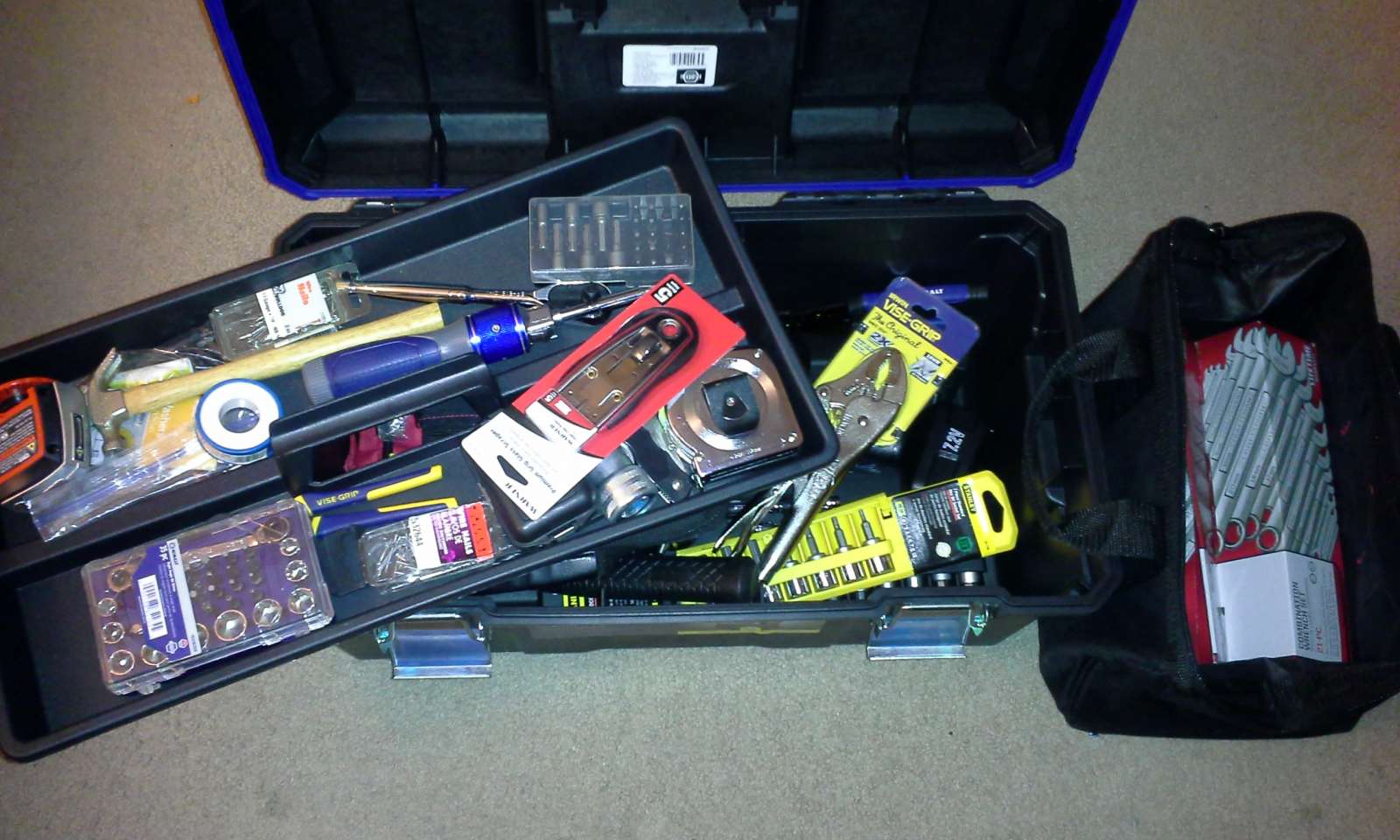
(Originally posted 2016-03-09)
I started following Deadspin’s “Adequate Man” (RIP, to both) sub-site from the beginning, intrigued by the idea of “let’s have some articles on how to be adequate at things”. Naturally, this has since devolved into other random stuff, but I was inspired to explore the topic of what an “adequate man” should have in his (or her) toolbox for around the house.
For this article, we’ll look at what tools you “should have”, and then I’ll also throw in some suggestions for “nice to have” items.
Tool Brands To Buy
I don’t claim to be an expert in what tools are the best; you should find a brand that works for you (and your budget), and hopefully that holds up. I do recommend spending a little more money (in most cases) than your rock-bottom Wal-mart specials, but that’s a personal preference – after all, if the cheap tool breaks, now you have to pay for it again, versus spending a little more up front.
Personally, I mostly get either Sears Craftsman tools, or Kobalt. I have stuff in both, and they’ve held up decently for me for plenty of around the house type work. The Craftsman tools generally come with a lifetime warranty as well, if I’m not mistaken, so if one *does* break, you’re also covered there.
Certain items, of course, don’t need to be high end. Your basic hammer, for example, or a decent tape measure. No need to get crazy – as my parents pointed out when gifting me my first set of tools as an apartment-warming present, “it’s a hammer”.
Speaking of toolsets – if you’re just starting out (or, like my parents, looking to help someone just starting out), it’s definitely worth looking into some kind of set. You’ll likely save money over buying it piecemeal, get a good chunk of what you need (plus some extras), and often, they’ll come with a bag or box to store said tools in. (See for example, this 32-piece Craftsman set.)
The Tools
A Hammer

Starting with the obvious. Pretty basic, really. Your standard, claw-end hammer. Regular size. Look for one with decent weight, and that doesn’t feel like the head’s going to come flying off.
Nice to have: A smaller hammer. I have one that came from a little tool set I got as a kid, and it’s great for when I want to put a nail in the wall to hold up a picture frame – gives me nice control.
Screwdrivers

Again, a “no duh” choice. You should have a set of both flat-bladed and Phillips. Probably at least 3-4 of each in a range of sizes.
Nice to have: 1. A ratcheting screwdriver – eases up wasted hand motions.

I have a Kobalt “dual drive” one, with changeable heads, and that theoretically can be set so that if I hold the collar, whichever way I turn the handle, the head turns in the direction (screw in or out) I set. (It’s ok, but not quite as great as it looked on tv. Usually my go-to screwdriver, though.)
2. Other screwdriver types (hex, star, Robertson). Mainly if you’ve got a lot of stuff that has special screws.
3. Electric drill with screwdriver heads.
Pliers
There’s actually 3 different types you’ll probably want here.
Slip-joint pliers. Your “basic” pliers.

Adjustable pliers (or tongue-and-groove or a whole host of names per Wikipedia). Adjustable to different sizes, good for gripping, working with plumbing (I used mine to put on a low-flow showerhead, for example).

Needle nose pliers. Good for the grabbing, crimping, etc., of small things.

Nice to have: Vise grips, most likely (the actual locking kind, not just the brand). Recommended by Clint Eastwood as all a good handyman needs to get started, along with duct tape and WD-40.

Wrenches (or “Spanners” for you British types)
Again, 2 main types for around the house/casual use:
Crescent (open-end or combination) wrenches in a variety of Standard/Imperial and Metric sizes.

Adjustable wrench for anything oddball. You can run with just this instead of most of the crescent wrenches if needed (I didn’t get crescent wrenches myself until just recently, when I decided to start filling out my tools).

Nice to have: An Allen wrench set. Especially if you put together cheap furniture.
Ratcheting Socket Wrench Set
I separated this out from the regular wrenches, as with additional headsets, a ratcheting wrench itself is just wonderfully useful. But you’ll want various sized socket heads (again, both Metric and Imperial) to drive nuts and bolts, basically. A word of advice – if you’re buying additional socket head sets that don’t come with their own wrench, make sure you get a wrench that fits (I had to buy a second, bigger one to fit some new socket sets I purchased).

Nice to have: Here’s where you can get crazy. Obviously, there’s different sizes of sockets. But the other good thing you can buy are drivers that fit on – e.g., I purchased Allen head drivers, because I hate turning that little dinky Allen wrench a little bit at a time, taking it out, resetting, then repeating, when I had to put furniture together. Putting the appropriate head onto the ratcheting wrench, you can whip right through that.

Another thing, if needed, is an open socket set. Basically, Kobalt for example makes a set of sockets with a special ratchet wrench and open sockets that allows you to remove nuts in cases where say, the bolt sticks up too far for your standard socket wrench set (ran into this once trying to help a friend take apart a futon to go out to the dumpster).
Tape Measure
Get the retracting kind, that locks. Not much more to say.

Cutting Implements
You may want a saw of some variety (I don’t currently, but I live in an apartment and so don’t usually cut anything that hard); at the least, you should have a utility knife.
Nice to have: Box cutter, flat-bladed razor/scraper.

A Good Toolbox or Bag
Obviously, you’ll want something to store your stuff in. If you have a small-ish amount of stuff that isn’t too bulky, you can get away with a good, sturdy bag. (Craftsman certainly has a good one for sale, with a firm bottom. Also, their starter tool sets often come with one.)

As you get more, you’ll likely want to graduate to some kind of box. Kobalt has a variety of sizes; I’ve currently got one that’s big enough to hold just about everything I’ve listed above in it, with still plenty of room to go, and they go bigger than the one I have. But you should get whatever you feel fits your needs (and storage space for the box itself) – the bag, the classic open-in-the-middle type, single hinged (smaller or larger), or even the more sturdy kind with pull-out drawers.

I hope this guide gives you some good advice on how to start (or improve) your tool situation. It should be a good basis for getting you through everyday kinds of jobs, like putting together furniture, swapping a showerhead, heck, even the occasional small car work (e.g., putting in a new battery). Got more ideas? Got brand suggestions? Feel free to suggest them in the comments below.


Get involved!
Comments